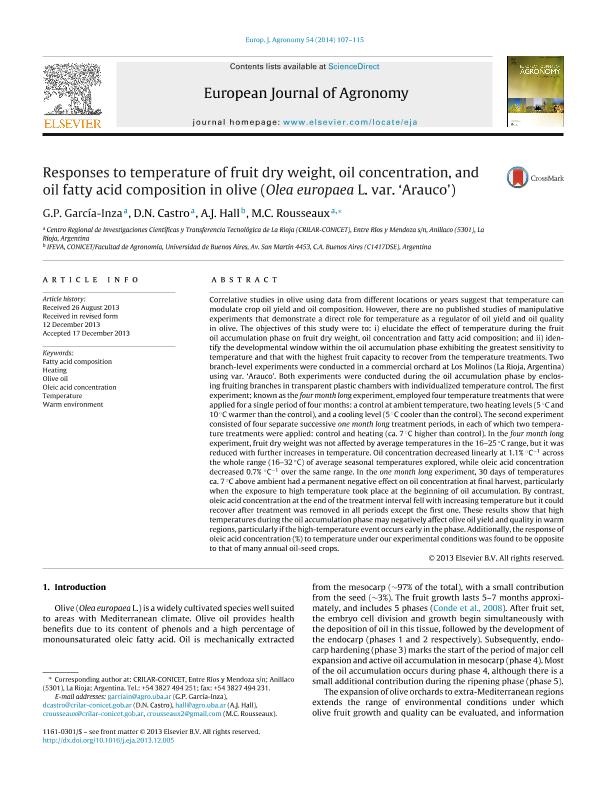Mostrar el registro sencillo del ítem
dc.contributor.author
García Inza, Georgina Paula

dc.contributor.author
Castro, Diego Nicolas

dc.contributor.author
Hall, Antonio Juan

dc.contributor.author
Rousseaux, Maria Cecilia

dc.date.available
2017-01-27T20:18:35Z
dc.date.issued
2014-03
dc.identifier.citation
García Inza, Georgina Paula; Castro, Diego Nicolas; Hall, Antonio Juan; Rousseaux, Maria Cecilia; Responses to temperature of fruit dry weight, oil concentration, and oil fatty acid composition in olive (Olea europaea L. var. 'Arauco'); Elsevier Science; European Journal of Agronomy; 54; 3-2014; 107-115
dc.identifier.issn
1161-0301
dc.identifier.uri
http://hdl.handle.net/11336/12102
dc.description.abstract
Correlative studies in olive using data from different locations or years suggest that temperature can modulate crop oil yield and oil composition. However, there are no published studies of manipulative experiments that demonstrate a direct role for temperature as a regulator of oil yield and oil quality in olive. The objectives of this study were to: i) elucidate the effect of temperature during the fruit oil accumulation phase on fruit dry weight, oil concentration and fatty acid composition; and ii) identify the developmental window within the oil accumulation phase exhibiting the greatest sensitivity to temperature and that with the highest fruit capacity to recover from the temperature treatments. Two branch-level experiments were conducted in a commercial orchard at Los Molinos (La Rioja, Argentina) using var. ‘Arauco’. Both experiments were conducted during the oil accumulation phase by enclosing fruiting branches in transparent plastic chambers with individualized temperature control. The first experiment; known as the four month long experiment, employed four temperature treatments that were applied for a single period of four months: a control at ambient temperature, two heating levels (5 °C and 10 °C warmer than the control), and a cooling level (5 °C cooler than the control). The second experiment consisted of four separate successive one month long treatment periods, in each of which two temperature treatments were applied: control and heating (ca. 7 °C higher than control). In the four month long experiment, fruit dry weight was not affected by average temperatures in the 16–25 °C range, but it was reduced with further increases in temperature. Oil concentration decreased linearly at 1.1% °C−1 across the whole range (16–32 °C) of average seasonal temperatures explored, while oleic acid concentration decreased 0.7% °C−1 over the same range. In the one month long experiment, 30 days of temperatures ca. 7 °C above ambient had a permanent negative effect on oil concentration at final harvest, particularly when the exposure to high temperature took place at the beginning of oil accumulation. By contrast, oleic acid concentration at the end of the treatment interval fell with increasing temperature but it could recover after treatment was removed in all periods except the first one. These results show that high temperatures during the oil accumulation phase may negatively affect olive oil yield and quality in warm regions, particularly if the high-temperature event occurs early in the phase. Additionally, the response of oleic acid concentration (%) to temperature under our experimental conditions was found to be opposite to that of many annual oil-seed crops.
dc.format
application/pdf
dc.language.iso
eng
dc.publisher
Elsevier Science

dc.rights
info:eu-repo/semantics/openAccess
dc.rights.uri
https://creativecommons.org/licenses/by-nc-nd/2.5/ar/
dc.subject
Fatty Acid Composition
dc.subject
Heating
dc.subject
Olive Oil
dc.subject
Oleic Acid Concentration
dc.subject
Temperature
dc.subject
Warm Enviroment
dc.subject.classification
Horticultura, Viticultura

dc.subject.classification
Agricultura, Silvicultura y Pesca

dc.subject.classification
CIENCIAS AGRÍCOLAS

dc.title
Responses to temperature of fruit dry weight, oil concentration, and oil fatty acid composition in olive (Olea europaea L. var. 'Arauco')
dc.type
info:eu-repo/semantics/article
dc.type
info:ar-repo/semantics/artículo
dc.type
info:eu-repo/semantics/publishedVersion
dc.date.updated
2017-01-27T13:28:46Z
dc.journal.volume
54
dc.journal.pagination
107-115
dc.journal.pais
Países Bajos

dc.journal.ciudad
Ámsterdam
dc.description.fil
Fil: García Inza, Georgina Paula. Consejo Nacional de Investigaciones Científicas y Técnicas. Centro Regional de Investigaciones Cientificas y Transferencia Tecnológica de Anillaco; Argentina
dc.description.fil
Fil: Castro, Diego Nicolas. Consejo Nacional de Investigaciones Científicas y Técnicas. Centro Regional de Investigaciones Cientificas y Transferencia Tecnológica de Anillaco; Argentina
dc.description.fil
Fil: Hall, Antonio Juan. Consejo Nacional de Investigaciones Científicas y Técnicas. Oficina de Coordinación Administrativa Parque Centenario. Instituto de Investigaciones Fisiológicas y Ecológicas Vinculadas A la Agricultura; Argentina. Universidad de Buenos Aires. Facultad de Agronomia; Argentina
dc.description.fil
Fil: Rousseaux, Maria Cecilia. Consejo Nacional de Investigaciones Científicas y Técnicas. Centro Regional de Investigaciones Cientificas y Transferencia Tecnológica de Anillaco; Argentina
dc.journal.title
European Journal of Agronomy

dc.relation.alternativeid
info:eu-repo/semantics/altIdentifier/url/http://www.sciencedirect.com/science/article/pii/S116103011300186X
dc.relation.alternativeid
info:eu-repo/semantics/altIdentifier/doi/http://dx.doi.org/10.1016/j.eja.2013.12.005
Archivos asociados
